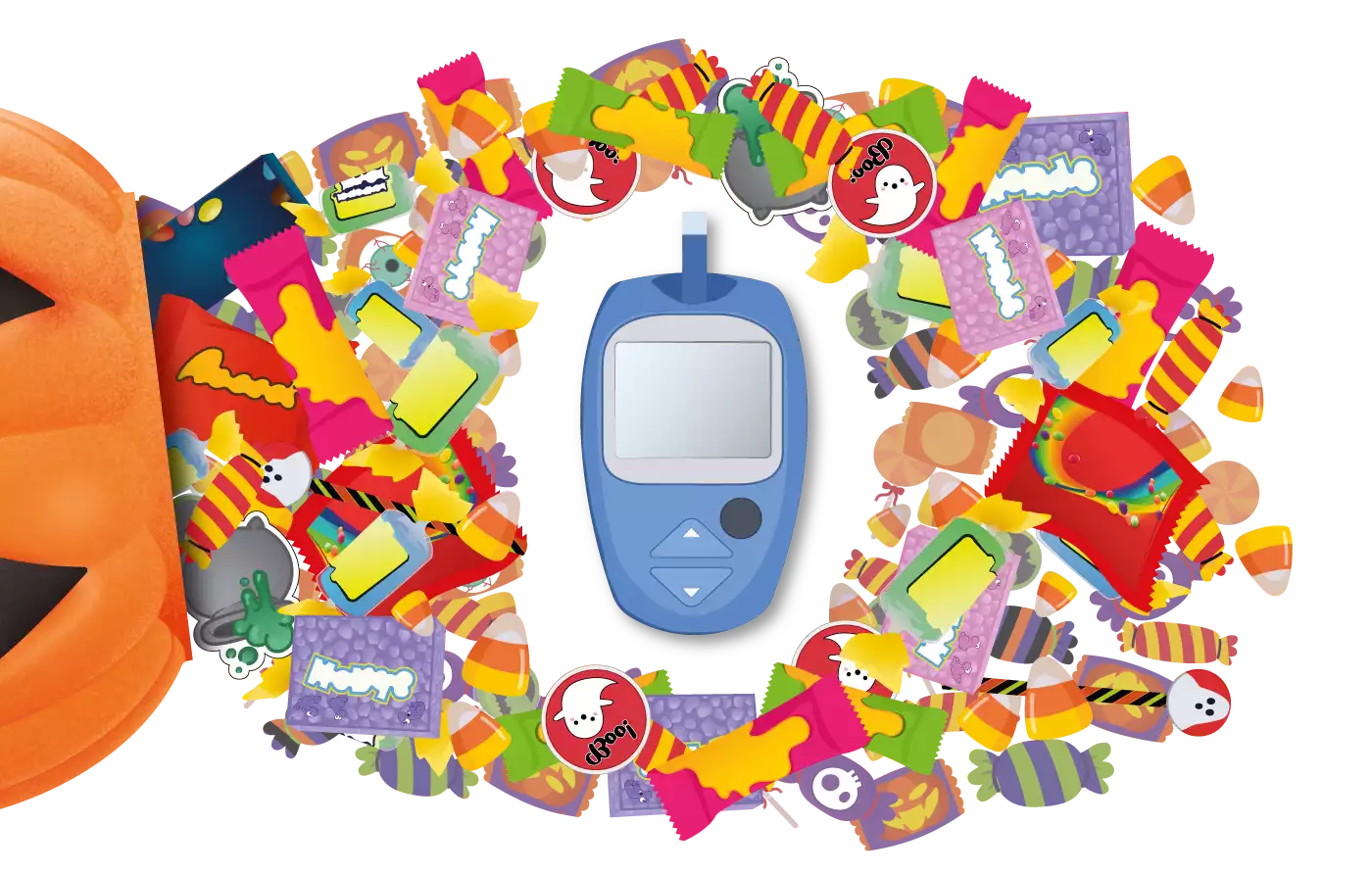29 OCTOBRE 2021
(Mis à jour le 7 octobre 2024)
Halloween
Conseils pour des festivités amusantes et sécuritaires.
Dans quelques jours, la frontière entre le monde des vivants et celui des morts s’amincira et donnera lieu à diverses célébrations. Pour cette occasion, nous vous présentons un aperçu des origines de la fête de l’Halloween au Canada. Nous vous proposons également quelques conseils pour célébrer tout en prenant soin de votre santé et votre sécurité à travers les diverses activités traditionnelles de cette fête.
L’Halloween au Canada
L’union de traditions celtiques et christianistes
Malgré qu’il n’y ait pas de certitude établie quant aux origines de la fête d’Halloween, de nombreux historiens présument qu’elle serait originaire des peuples celtes de l’Europe ancienne. Ainsi, la tradition d’Halloween au Canada aurait pris ses racines dans un festival celtique nommé Samhain (prononcé « SOW-in »).
Selon les Celtes, durant la nuit du 31 octobre se produit la période de division entre le cycle où les jours sont plus longs que les nuits et celui où les nuits sont plus longues que les jours. Pendant cette période, la séparation entre le monde des morts et des vivants s’atténue, offrant ainsi aux âmes des défunts, aux fantômes et aux démons l’occasion de passer du côté des vivants. Dans cette tradition, certaines pratiques, comme se costumer et présenter des offrandes, serviraient à éloigner et adoucir les esprits malfaisants.
Son arrivée au Canada daterait donc du milieu du 19e siècle lors de l’arrivée d’une importante vague d’immigrants irlandais et écossais. Les traditions de la Samhain auraient ensuite été combinées à celles de la fête chrétienne de la Toussaint. En effet, le terme Halloween découlerait de All Hallows Eve pouvant être traduit par « la veille de tous les Saints ».
D’où vient la fameuse tradition des
citrouilles-lanternes (Jack-o’-lanterns)
Elle proviendrait d’une légende ancienne qui raconte l’histoire d’un homme malicieux et ivrogne, nommé Stingy Jack, qui aurait déjoué le diable deux fois plutôt qu’une. La légende dit que le Diable serait descendu de l’Enfer afin de le punir pour son comportement inacceptable. Malheureusement, étant rusé, Jack aurait réussi à garder le Diable prisonnier en l’entourant de croix. Pour être libéré, le Diable dut promettre à Jack qu’il ne viendrait plus jamais l’embêter. Plus tard, lorsque l’homme mourut, le Paradis ne voulut pas de lui et, en Enfer, le Diable non plus, puisque telle était sa promesse. On raconte que depuis ce temps, Jack erre entre le monde des morts et des vivants. Ainsi, la population créa des citrouilles-lanternes afin d’éloigner les âmes errantes, comme Jack. Ainsi, creuser des citrouilles pour y apposer et y allumer des bougies sert à protéger sa maison des mauvais esprits.

AVANT DE CREUSER VOTRE PROPRE CITROUILLE, N’OUBLIEZ PAS CES PRÉCAUTIONS :
1. Utilisez un kit d’outils spécialement conçut pour cette activité diminuer les risques de blessure.
2. Préparez bien votre espace et vos outils de travail.
Votre espace doit être bien éclairé et la surface de travail doit être stable et plane. Rien ne doit être mouillé ou humide afin d’éviter qu’il y ait quoi que ce soit de glissant.
3. Sculptez la citrouille avant de la vider.
Vous éviterez ainsi la tentation de mettre la main à l’intérieur durant la découpe. Vous pouvez toutefois préalablement couper un peu la citrouille à la base afin d’assurer sa stabilité.
4. Le découpage doit être fait par un adulte.
Bien sûr, ça ne veut pas dire que les enfants ne peuvent pas participer. Ils peuvent aider à vider la citrouille, à dessiner les motifs du visage et à la décorer.
QUELQUES CONSEILS POUR QUE VOTRE HALLOWEEN NE TOURNE PAS EN FILM D’HORREUR
Autant pour creuser des citrouilles en famille, que pour distribuer des bonbons, faire la fête ou prendre votre voiture le soir d’Halloween, il est important de prendre certaines mesures pour assurer la sécurité de tous. Ces simples précautions vous permettront donc de célébrer l’Halloween en toute tranquillité d’esprit !

La récolte
1. Veillez à ce que votre costume et celui des enfants permette de bien voir et bouger.
• Optez pour du maquillage pour éviter de gêner la vision. Assurez-vous toutefois de maquiller les enfants avec des produits hypoallergéniques et non toxiques.
• Assurez-vous d’être bien visible pour les conducteurs en ajoutant des bandes réfléchissantes au costume.
2. Rappelez aux enfants les règles de sécurité pour les piétons.
• Faire preuve de vigilance en tout temps.
• Traverser prudemment aux passages pour piétons et aux intersections.
• Ne jamais traverser entre les voitures stationnées.
3. Avertissez vos enfants de ne pas manger de bonbons avant qu’ils aient été examinés à leur retour à la maison.
La distribution de bonbons
1. Assurez-vous que le devant de votre maison est bien éclairé.
• Un éclairage sombre contribue à l’atmosphère sinistre de vos décorations. Cependant, les visiteurs pourraient avoir plus de difficulté à voir leur chemin, ce qui augmente les risques d’incidents, comme une chute.
2. Dégagez bien le passage pour y circuler sans risque de trébucher et de se blesser.
3. Gardez les animaux domestiques à l’écart dans une autre pièce.
• L’excitation des enfants, le va-et-vient constant, les accessoires lumineux et les bruits forts peuvent stresser vos animaux et peuvent occasionner des comportements réactifs ou inhabituels.
• Il faut aussi faire attention de garder les bonbons et les emballages hors de leur portée. Pour vos compagnons, la consommation de bonbons peut causer de graves problèmes de santé.


Les festivités
1. Bien entendu, les conseils précédents visant la sécurité de vos animaux sont également applicables dans ce contexte
2. Dégagez l’espace le mieux possible.
• Ainsi, vous évitez qu’un invité trébuche et se blesse. Par exemple, si vous avez une table basse dans le salon, déplacez-la dans une chambre.
3. Évitez l’obscurité totale.
• Par exemple, tamisez les lumières de la pièce principale et allumez celles des passages principaux, comme celui qui mène aux toilettes.
4. Utilisez des petits lampions à piles pour éclairer vos citrouilles, plutôt que des vraies chandelles.
5. Faites appel à un service de raccompagnement, tel que Tolérance-Zéro, pour que vos invités retournent à la maison en toute sécurité.
• Conduire avec les facultés affaiblies n’est JAMAIS une bonne idée.
La conduite automobile
1. Soyez encore plus attentifs et alertes qu’à l’habitude.
• Soyez patients et roulez lentement pour éviter, par exemple, une collision avec un enfant qui a oublié les règles de sécurité et qui s’est aventuré à traverser la rue entre deux voitures stationnées.
2. Évitez toutes distractions. Par exemple, attendez d’être arrêtés pour changer de chanson ou pour répondre au téléphone.
• Malgré que ce soit une règle qui devrait être pratiquée en tout temps, elle est d’autant plus importante lors de cet événement au cours duquel de nombreux enfants parcourent les rues.


Le diabète
Bien que l’Halloween soit une fête terrifiante, un diagnostic de diabète ne devrait pas faire partie des choses qui inspirent de la peur ce jour-là. Tant pour les grands que les petits, une bonne préparation peut permettre d’apprécier cet événement monstrueusement amusant.
1. Vérifiez que les adultes responsables sont bien informés sur ;
• la quantité de bonbons qui peuvent être mangés et les friandises à éviter ;
• la bonne quantité d’insuline selon les circonstances ;
• les signes d’hypo/hyperglycémie, et ce qu’il faut faire si une telle situation survient.
2. Évitez le froid et les baisses de glycémie en apportant des vêtements chauds.
3. Assurez-vous que la pompe et le glucomètre restent à portée de main.
4. Planifiez la possibilité de consommer des bonbons pendant et après la récolte.
Ma citrouille turquoise
Une initiative remarquable pour rendre la traditionnelle récolte d’Halloween plus inclusive pour les enfants allergiques!
Créée au Tennessee en 2012, c’est en 2015 que l’initiative prit racine au Canada.
Le concept est simple, déposez une citrouille turquoise devant votre maison pour indiquer que vous offrirez des surprises non comestibles le soir de l’Halloween.
À titre d’exemple, vous pourriez offrir :
• des autocollants ;
• des crayons rigolos ;
• des bagues araignées ;
• ou des bulles.
Bien sûr, ça n’exclut pas que vous puissiez également donner des bonbons aux autres enfants. Dans ce cas, il est préférable d’offrir des bonbons exempts des allergènes les plus répandus au cas où un enfant allergique se retrouverait avec un de ces sacs.
Selon Allergies Québec, les 9 allergènes prioritaires sont les arachides, le blé, le lait, la moutarde, les noix, les œufs, les poissons et fruits de mer, le sésame et le soja.
Assurez-vous également que l’emballage individuel des bonbons que vous distribuez contient la liste des ingrédients.

Premiers secours
Une préparation essentielle
La meilleure manière de célébrer en toute tranquillité d’esprit est d’être en mesure d’intervenir si un incident survient. Apprendre les bases du secourisme, c’est quelques heures de votre temps qui pourraient faire toute la différence.
Apprenez à votre rythme grâce à nos formations 100% en ligne!
Rédigé par Laurie Lévesque, créatrice de contenu.
Révisé, illustré et mis en page par Émilie Bedard, responsable des communications